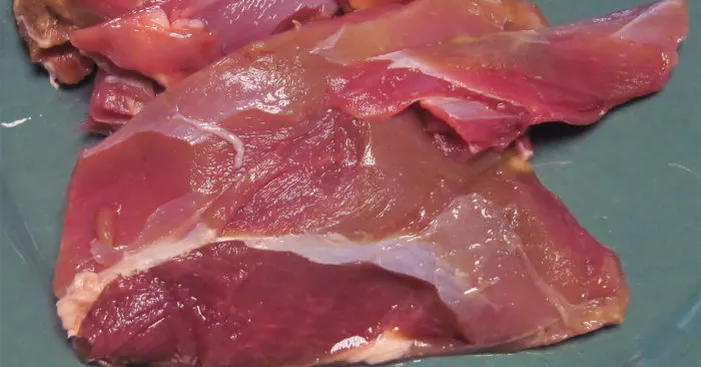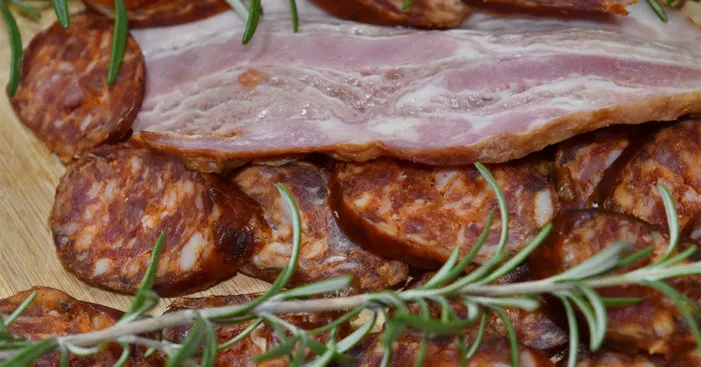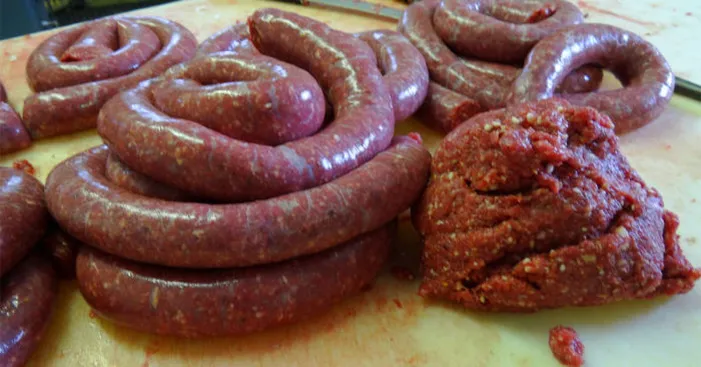Table of Contents

Venison sausage (deer sausage) basically comes from the meat of game animals but through time it started mainly referring to the meat of elk or deer.
Deer belong to mammals that reproduce by birth and nurse their youngsters.
Throughout ancient civilization and until nowadays, deer have always been considered a symbol of beauty.
This is because of its elegance and lightness of movement which resembles that of royalties.
However, the most important characteristic of deer is that its ability to run or jump fast.
Thanks to that frequent physical activity, deer meat is more worked out and is considered a delicacy.
By any means, we do not encourage hunting deer for meat as this article is purely educational.
In this article, we are going to go through all the characteristics of venison sausage (deer sausage), venison nutrition facts, health benefits, how to cook it, how to buy and store it, and the precautions you need to know before you consume it.
Venison nutrition facts:
Calories in venison:
These data count for the recommended daily intake of (80g to 3oz) cooked venison:

- Calories: 125
- Protein: 17.4g
- Cholesterol: 70mg
- Fat: 5.6g
- E vitamin: 2%
- B1 vitamin: 28%
- B3 vitamin: 22%
- B6 vitamin: 18%
- B12 vitamin: 24%
- Copper: 5%
- Iron: 14%
- Magnesium: 4%
- Phosphorus: 17%
- Potassium: 7%
- Zinc: 25%
- Selenium: 12%
Venison healthy:

May prevent kidney diseases:
The serving size of venison is just 85g and it contains 29% of B1, 33% of B12, 39% of B3, and 22% of B6.
All of these vitamins and other components in venison make it beneficial for our kidneys.
In fact, several studies show the great effect of B vitamins in stabilizing kidney function.
By consuming venison meat once a week you will be giving your kidneys a better chance to remain healthy.
Enhancing bones health:
Usually, red meat including pork, beef, lamb, or bison contains saturated fats which are bad for our health.
However, this is not the case for venison meat or deer sausage.
The saturated fats in venison are good, especially for your bones health.
Did you know that without saturated fats your bones health will significantly decline?!
For instance, the USDA recommends getting between 20 and 30g of saturated fats daily.
By consuming just a serving of venison meat you get 3g of saturated fats.
That is way below the limit of the daily safe dose of saturated fat which is a way it will benefit your bones.
Also, deer sausage contains calcium which is an essential mineral to build and protect bones.
Deer sausage benefits the bones and the only thing that you need to consider is the portion!
Sometimes you don’t focus on how much you eat, we all continue eating when the food is delicious.
With venison sausage and red meat in general, you only need a portion the size of your palm.
Prevents high cholesterol:
Another benefit of the B vitamins in venison sausage is that they prevent high cholesterol levels.
The role of B3, B6, and B12 is to increase the good cholesterol (HDL) which removes bad cholesterol (LDL).
By reducing bad cholesterol from blood streamlines there is a lower risk of getting cardiovascular diseases.
Treats lung diseases:
Potassium, Iron, and Phosphorus are among the other minerals that come abundantly in venison sausage.
All of these nutrients combined are very good for preventing vital organs damage including the lungs.
The consumption of deer or venison sausage adds extra immunity and helps cleaning toxins.
Being exposed to air pollution, the lungs usually accumulate pollutants and it is necessary to clean them in order to prevent possible lung diseases.
The consumption of deer meat adds extra immunity to the characteristics of pollutants.
Good for diabetic people:
Vitamin B6 in venison sausage is highly beneficial for diabetic people suffering from complications due to unbalanced sugar levels.
Also, this vitamin is able to reduce accumulated protein glycation which fastens aging and complicates diabetes.
Prevents anemia:
By consuming the serving size of 3oz (85g) of venison or deer sausage you will get 13% of the daily need in Iron.
This is a key component in building hemoglobin which prevents anemia or hemoglobin deficiency.
This is vital information as our red blood cells get damaged over time and need to be replaced with new ones.
Because of that, eating deer sausage will prevent iron deficiency and anemia.
Healthy for pregnant women:
During pregnancy, women need a well-balanced diet as they share it with the fetus.
Because of that, they need highly nutritious food to ensure that they cover their own nutrients need.
Therefore, eating deer sausage will provide the pregnant woman’s body with most of her daily nutrients needs.
In addition, the iron supply in this type of meat is what the pregnant woman needs to transmit nutrition to her fetus.
Studies show that it is completely safe for women during pregnancy to eat cooked venison sausage.
Preserves hormonal levels:
When a person is dealing with obesity in which the bad cholesterol levels are high, it can be really dangerous.
In fact, high cholesterol levels in the blood caused by obesity greatly reduce the level of hormones in the body.
Because of that, it is a healthier choice to move from beef, pork, and lamb to venison meat.
By doing that, your body will have a better chance to maintain its hormonal levels.
Enhances muscle mass:
This is probably the most famous piece of information: to increase muscle mass, you need protein!
Did you know that venison sausage contains more protein than lamb or beef for the same portion size?
In fact, deer meat contains 26g of protein compared to 22g in beef and 10g in lamb.
That abundance of protein is almost equal to that in chicken breasts for the same servings.
Relief menstruation cramps:
During periods, most women experience pain in their lower abdomen due to cramps.
Thankfully, deer sausage is a great source of vitamin B1, B3, and B12.
In fact, 87% of women taking 200mg of B3 daily had less painful period cramps according to PeaceHealth.
Venison sausage contains more than 30% of your daily need in B1, B3, and B12 per serving.
Because of that, if menstruation cramps are intense you may think of consuming deer sausage.
Other health benefits of deer sausage:
- Deer sausage is a great source of high-quality protein. Athletes and others who exercise a lot can use this meat to meet their need for protein.
- Venison or deer sausage contains a wide range of antioxidants that can reduce the risks of cancer.
- Consuming venison bacon prevents the development of beriberi, strengthens immunity, and increases bacterial and fungal infections.
- Venison sausage contains 5g of fat per serving and that is less than half of the fat of pork or beef for the same size. By consuming deer sausage instead of other red meat, you would have a better chance of losing weight.
- By eating venison meat you will strengthen the walls of your digestive tract.
- Also, it promotes a healthier functioning of the stomach by increasing the production of enzymes.
- Regular consumption of deer sausage (2 times a week) supplies your body with B vitamins.
- That would prevent the development of depression and neutralize the effect of stress on the body.
- Thanks to its richness in zinc, venison bacon is beneficial for our sexual health as it can treat erectile dysfunction and promote sperm production.
- The nutrients in venison meat help regulate blood pressure and blood sugar levels. Therefore, it is very useful for diabetic people to consume this meat at least once a week.
- The substances present in deer meat help regulate blood sugar and normalize blood pressure. For people with diabetes and high blood pressure, it is useful to include this product in your diet at least every 5 to 6 days.
- In Chinese medicine, they grind dried deer meat to obtain a powder that they use later on in creams and gels for skincare.
- They proclaim that this powder restores the elasticity of the skin and opposes the effects of aging.
Precautions before you consume deer meat:

Venison meat is generally good for our health as long as it’s a part of a balanced diet.
However, there are rare cases where this type of meat may complicate an already existent condition.
For instance, it is not good for people who have gout to eat venison because of its high purine content.
Also, bison, wild rabbit, and venison meat offal should not be consumed as they may be rich in cadmium.
Cadmium content:
This is a toxic metal that exists in most wild herbivorous animals and especially in their offal.
For instance, the kidneys and the liver of deer usually contain large amounts of cadmium.
Most specialists believe it is because these wild animals consume lichen, a plant exposed to air pollution.
This means that farmed animals do not pose this risk as they don’t eat lichen.
Because of that, it is best to not consume offal from wild deer as a precautionary measure.
This precaution is even more important for smokers as they are already exposed to cadmium.
In addition, people with a lower immunity system like children, the elderly, people with chronic diseases, and pregnant women must all be cautious.
Beware of barbecuing:
When we cook meat at a very high temperature, certain carcinogenic compounds may form.
For instance, polycyclic aromatic hydrocarbons (PAHs) and heterocyclic amines (HCAs) can form when the meat is cooked at a high temperature.
The amount of these carcinogenic depends on the time and degree of cooking.
Barbecuing and grilling produce large amounts of these toxic components.
On the other hand, other methods like baking, simmering, or roasting produces negligible amounts.
Finally, make sure you cook venison enough to kill bacteria but try to avoid overcooking.
Cooking venison:

Venison in the oven:
Ingredients:
- 1 lb of venison meat (500g) or venison sausage or deer sausage.
- ½ tsp of ground black pepper.
- 3 tbsp of vinegar.
- 5 tbsp of soy.
- 2 tbsp of vegetable oil.
- ½ tsp of oregano (or rosemary).
- ½ tsp of paprika.
- 2 tbsp of tomato sauce (or 2 chopped tomatoes).
- 1 tbsp ketchup.
- 2 garlic cloves chopped.
- ½ chopped onion.
- ¼ tsp of salt.
- 1 tsp of basil.
Preparation:
- In a bowl, mix soy sauce, tomato sauce, ketchup, onion, onion, salt, basil, black pepper, paprika, vinegar, and vegetable oil and mix them all.
- Add the venison meat to the bowl make sure it is fully seasoned with the mixture.
- Cover the bowl and put it in the refrigerator for 24 hours in order for the meat to absorb all the flavors.
- The next day, pour the bowl into an oven tray and spread it evenly, then let it cook for 25 minutes at 350°F (180°C).
- Take it out, serve it and enjoy it! (this dish can serve up to 6 people).
Venison and potatoes:
Ingredients:
- 1 bell pepper.
- 2lbs of venison meat or venison sausage (1Kg).
- 1 tbsp of vinegar.
- 5 medium potatoes.
- 1lbs of chopped mushrooms (500g).
- 1 chopped onion.
- 1 tsp of ground black pepper.
- ½ tsp of salt.
Preparation:
- Start by heating the oven at 350°F (180°C).
- Cut the venison meat or sausage into small pieces.
- Then, stir the pieces of meat on a pan just enough until their skin turns golden.
- Now add the chopped onion, potatoes, bell pepper, mushrooms, vinegar, ground black pepper, and salt.
- Keep stirring to mix all the ingredients together as they cook on the pan.
- When the onion starts turning yellow, pour the pan on an oven tray and cover it with aluminum foil.
- Put the tray in the oven and let it bake for 50 minutes.
- Take it out, serve it and enjoy it! (this dish can serve up to 4 people).
Buying venison:

Venison meat has a dark red color when it is fresh, except for young animals which may have pink meat.
Meat from wild animals is also subject to the same inspections and regulations as ordinary meat.
This means that once you find venison meat at your store it is totally safe to buy and consume.
Even though it is still very rare to find this type of meat in the market, but you can still find sub-products such as venison or deer sausage.
You can also purchase deer meat directly from producers as some of them have begun to switch to this type of meat.
Also, deer meat does not need to be marinated and will remain pink on the inside after cooking.
You can buy this meat fresh and frozen, however, always check the date of packaging to ensure it’s fresh.
Storing venison meat (deer meat):

In the refrigerator:
In order to avoid the risks of cross-contamination, here are our tips to refrigerate venison meat the healthiest way possible:
- As soon as you reach home, wash venison meat with water and few drops of vinegar to get rid of blood residues and bacteria.
- Wrap the meat in a piece of cloth or any air-permeable packaging to allow cold air to circulate and evacuate humidity.
- Store the meat in the refrigerator between 32 and 40°F (0 to 4°C) for up to 3 days.
In the freezer:
Freezing allows you to store this delicious meat from one hunting season to the next one.
Don’t worry, freezing venison meat does not change its taste either its nutritional values.
In order to freeze venison meat:
- Freeze it as soon as you get home, a pre-refrigeration is not mandatory but it will add to the tenderness of the meat.
- Make sure you put it in an airtight container or plastic foil to avoid freezing burns.
- Indicate the freezing date on the package and keep it frozen for up to 8 months.
Thawing frozen venison:
Mastering this phase is necessary in order to maintain the quality of venison meat.
In order to thaw frozen venison:
- Start by removing the plastic foil or removing the meat from the container.
- Wrap the meat with a piece of clean cloth then place it in the refrigerator for no longer than 12 hours before consumption.
- Make sure you only thaw the amount of venison you need as you can’t refreeze it once you thaw it.
Notice: Meat should not be soaked in its own juice after thawing to avoid bacteria.
